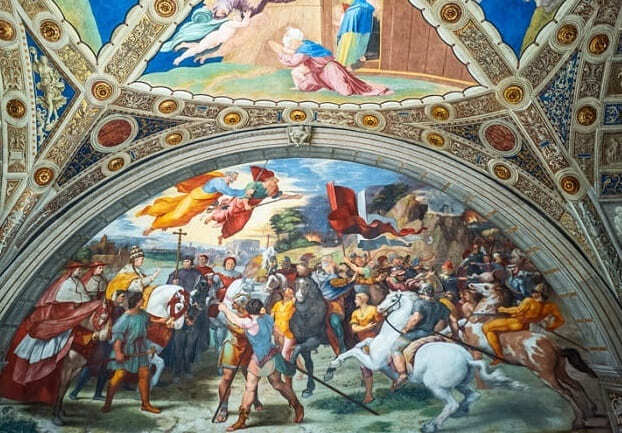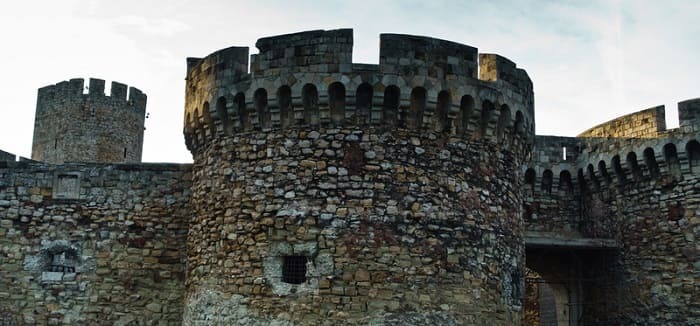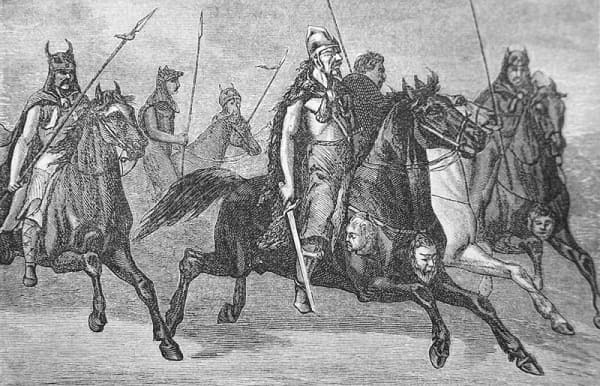

Huns were a confederation of Eurasian tribes with a Turkic-speaking elite who first arrived in Europe in the fourth century, their origins have long been a matter of controversy. Due to their combat prowess, exceptional mobility, and weapons like the Hun bow, they beat their rivals militarily.
From 434 until 453 AD, Attila, also known as Flagellum Dei (Latin for "Scourge of God"), ruled the Huns (ruling jointly with his elder brother Bleda until 445).
He was one of the most fearsome barbarian tyrants to attack the Roman Empire, and before he conquered Gaul and Italy, he first established control over Greece and the southern Balkan provinces. He is known as Etzel in the Nibelungenlied and Atli in Icelandic sagas.
Regarding Attila's early years, just his birthdate is known. He first appears in historical sources when he and his brother Bleda are chosen as the joint monarchs of the Huns.

Meeting room painting in Vatican Museums, Room of Heliodorus, the meeting between Pope Leone Magno and Attila, painted by Raffaello
A region not far from the Caspian Sea in the east to the Alps and the Baltic in the west appears to have been covered by the empire that Attila and his older brother Bleda acquired control over.
After establishing the unified rule, they initially negotiated and signed a peace treaty with the Eastern Roman Empire in the city of Margus (Poarevac).
The Romans also pledged to pay the Huns 700 pounds (300 lb) of gold annually going forward and to treble the subsidies they had been providing to them. Attila's activities between 435 and 439 are unknown, but it appears that he was busy pacifying barbarian populations to the north or east of his empire.
It appears that the Eastern Romans did not pay the amounts specified in the Margus Treaty because Attila made a strong attack on the Danubian frontier in 441 when the Eastern Empire's armies were occupied in the west and on the eastern limit.
Several significant cities, notably Singidunum, were taken by him and destroyed (Belgrade).After the peace treaty was signed in the fall of 443, Attila's exact actions are unknown. He killed his brother Bleda around 445 and thereafter rose to power as the leader of the Huns. In 447, he launched his second significant assault on the Eastern Roman Empire, though the specifics of the operation remain unknown.

Bridge and towers of Singidunum or Kalemegdan fortress in Belgrade
It was intended on a scale that was much greater than that of 441-443, and it was launched farther east than the earlier attack. Its primary targets were the southern European provinces of Lower Scythia and Moesia. On the Utus (Vid) River, he battled the soldiers of the Eastern Empire and routed them, but at a tremendous personal cost.
He then ravaged the Balkan provinces before entering Greece from the south, stopping only at Thermopylae. In the three years that followed the invasion, Attila and the ambassadors of the Eastern Roman emperor Theodosius II engaged in protracted discussions. The chapters of the History of Priscus of Panium, who accompanied a Roman delegation to Attila's headquarters in Walachia in 449, contain a wealth of information regarding these diplomatic encounters.The peace treaty that put an end to the war was more severe than the one in 443; the Eastern Romans were compelled to abandon a sizable portion of their homeland south of the Danube and stayed to pay tribute, though it is uncertain how much.
Attila invaded and devasted Italy on his way back in 452 to renew his marriage to Honoria. His army ransacked various cities and destroyed Aquileia, leaving no traces of it left. To watch the city burn, he constructed a fortress on a hill north of Aquileia. From there, he established the town of Udine, which is now where the castle lies. Aetius stayed in the field but was unable to engage in combat as Valentinian withdrew from Ravenna to Rome.
When Attila finally arrived at the Po, he was welcomed by an embassy that included Pope Leo I, Prefect Trigetius, and Consul Aviennus. He withdrew his forces after the meeting without winning Honoria's favour or the required provinces.
According to Priscus, the Huns were held back by their superstitious fear of what would happen to Alaric, who passed away soon after sacking Rome in 410.
The pious "fable which has been depicted by the pencil of Raphael and the chisel of Algardi" (as Gibbon put it) of Prosper of Aquitaine claims that the Pope persuaded him to flee the city with the help of Saint Peter and Saint Paul.

Attila travelled to his palace by way of the Danube after departing from Italy. From there, he intended to launch another assault on Constantinople to recover the tribute Marcian had cut off. However, he passed away in the first few months of 453, choking to death in a trance the night following a feast honouring his most recent marriage to the attractive and young Ildico, according to the traditional narrative from Priscus.
Attila is known as the menacing "Scourge of God" in Western mythology and history, and his name has come to stand for brutality and violence. This may be in part because people often equate him with later steppe tyrants like Genghis Khan and Tamerlane, who are all characterised as harsh, crafty, and sanguinary warriors and looters. The reality of his character can be more complicated.
By the time of Theodosius' mission in 448, Priscus could recognise Hunnic, Gothic, and Latin as the three common languages of the horde since the Huns of Attila's period had been engaging with Roman civilization for some time, especially through the Germanic foederati of the frontier.
Q1. Who defeated Attila the Hun?
Ans. In the Battle of the Catalaunian Plains, or, according to some sources, of Maurica, Attila attempted to conquer Gaul in 451 but was repulsed by Roman and Visigothic armies. In this conflict, Attila lost just one battle.
Q2. Who saved Rome from Attila?
Ans. Leo, a member of the Roman nobility, was the first pope to be referred to as "the Great." Perhaps his most famous accomplishment is convincing Attila the Hun to abandon his invasion of Italy in 452.
Q3. Why does Attila matter?
Ans. Of all the barbarian kings that attacked the Roman Empire, Attila was one of the most powerful. Because he refused to give his sister, half of the Western Empire as a dowry, the Western Roman emperor asked the Eastern Roman Empire for an annual payment in gold before assaulting Gaul and Italy.